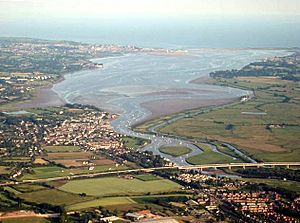Exe Estuary facts for kids
Quick facts for kids
Designations
|
|
| Official name: Exe Estuary | |
| Designated: | 11 March 1992 |
|---|---|
| Reference #: | 542 |
The Exe estuary is a special place where the River Exe meets the sea on the south coast of Devon, England.
This estuary starts just south of the city of Exeter. It stretches south for about eight miles until it reaches the English Channel. An estuary like this is called a ria, which means it's a drowned river valley. This makes it much bigger than you might expect for the size of the River Exe itself.
On the east side of the estuary, you'll find the town of Topsham. Further south are the villages of Exton and Lympstone. At the very mouth of the estuary is the popular seaside town of Exmouth. Across from Exmouth, on the west side, is the village of Dawlish Warren. It has a long sand spit that reaches out into the estuary's mouth. Higher up on the west side, there are fewer towns. You'll only find the villages of Starcross and Cockwood closer to the lower part of the estuary.
Other rivers also flow into the Exe estuary. The River Clyst joins just below Topsham. The River Kenn flows into the estuary near Kenton. The ground around the estuary is made of alluvial soil. This soil comes from older rocks like Devonian, Carboniferous, and Permian rocks.
Contents
Why is the Exe Estuary Important?
The Exe Estuary is a very important natural area. It has special protections to keep its wildlife safe. It is known as a Special Protection Area and a SSSI. It is also a Ramsar site, which means it's a wetland of international importance.
A Home for Wading Birds
The Exe Estuary is super important for wading birds from all over the world. These birds love to feed on the muddy flats when the tide is low. When the tide comes in, they fly to safe resting places. These include the Dawlish Warren SSSI and Bowling Green Marsh. The RSPB has two nature reserves right next to the estuary. These are at Bowling Green Marsh and Exminster Marshes.
More than 10,000 wildfowl and 20,000 wading birds spend the winter here. Some of these amazing birds include the dark-bellied brent goose. You might also spot Eurasian wigeon, ringed plover, black-tailed godwit, and the beautiful pied avocet.
Plants and Insects of the Marshes
The Exminster Marshes are a series of fields with ditches and dykes to drain water. They are home to several plants that are rare in Devon. These include parsley water dropwort, flowering rush, and frogbit. The marshes also support many dragonflies. Look out for the ruddy darter and the hairy dragonfly.
The Exeter Canal runs alongside the marshes. Both the canal and the marshes have thick beds of common reed. These reeds provide an important home for Old World warblers.
Amazing Creatures in the Mud and Sand
The sandbanks and mudflats of the estuary are full of creatures that burrow. You can find lugworms, peppery furrow shells, and tellins. There are also common cockles, pod razors, sea potatoes, and masked crabs. Beds of blue mussels are a tasty meal for Eurasian oystercatchers. The Exe estuary is also the only place in Britain where you can find a special worm called Ophelia bicornia.
Exploring the Exe Estuary
You can explore the Exe estuary by following the Exe Valley Way Footpath. This path starts south of Starcross. It goes north through the entire Exe estuary. It continues even further north, all the way to the heights of Exmoor. The path ends at the source of the River Exe, called Exe Head. This long route covers almost 50 miles.


